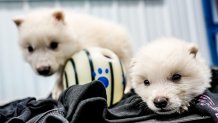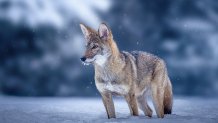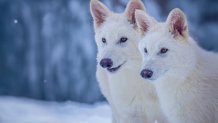Colossal Biosciences announced the birth of three dire wolves, a species that was extinct for nearly 13,000 years.
Winter is coming ... and so are the dire wolves.
The large canines — best known for being featured in the HBO series "Game of Thrones" — went extinct nearly 13,000 years ago. But they're now making a comeback.
Watch NBC6 free wherever you are
Colossal Biosciences, a Dallas-based biotech company, announced Monday it has revived the species by breeding three wolf pups that carry genes of their long-lost ancestors.
As part of a gene-editing restoration process the company calls de-extinction, the DNA from the fossils of dire wolves was extracted and used to edit the genes of gray wolves. Those edited cells were used to create embryos that were transferred to surrogates, leading to the rebirth of an extinct species.
Get local news you need to know to start your day with NBC 6's News Headlines newsletter.
The three pups, who were born six months ago, are named Romulus, Remus and Khaleesi. They feature traits of dire wolves -- including a larger, stronger body and a longer, fuller coat with light pigmentation.

"This massive milestone is the first of many coming examples demonstrating that our end-to-end de-extinction technology stack works,” said Ben Lamm, the CEO of Colossal. “Our team took DNA from a 13,000-year-old tooth and a 72,000-year-old skull and made healthy dire wolf puppies."
Don't call it a comeback, some experts say.
University at Buffalo biologist Vincent Lynch told NBC News the results only bring back the exterior semblance of an extinct species. Additionally, Lynch stresses this latest effort doesn’t mean dire wolves are coming back to North American grasslands any time soon.
“All you can do now is make something look superficially like something else”— not fully revive extinct species, he said.
How was dire wolf DNA discovered?
Colossal scientists learned about specific traits that dire wolves possessed by examining ancient DNA from fossils.
Researchers studied a 13,000 year-old dire wolf tooth unearthed in Ohio and a 72,000 year-old skull fragment found in Idaho — both part of natural history museum collections.
Beth Shapiro, Colossal’s chief scientist, says the scientists then took blood cells from a living gray wolf and used CRISPR to genetically modify them in 20 different sites.
They transferred that genetic material to an egg cell from a domestic dog, Shapiro said. When ready, embryos were transferred to surrogates, also domestic dogs, and 62 days later the genetically engineered pups were born.
Where do the dire wolf pups live?
The pups live in an undisclosed 2,000-plus acre preserve in the northern United States that Colossal says is enclosed by a "10-foot-tall, zoo-grade fencing with redundant perimeter security." Ten full-time animal care staffers tend to the wolves' well-being.
Colossal also announced that it birthed two litters of cloned red wolves, an endangered species, by using a new approach to non-invasive blood cloning. In March, the company revealed the birth of the woolly mouse -- mice featuring mammoth-like traits engineered by gene modifications.

"It was once said, ‘any sufficiently advanced technology is indistinguishable from magic,’” Lamm said. “Today, our team gets to unveil some of the magic they are working on and its broader impact on conservation.”
Colossal is calling the dire wolf the world’s first successfully de-extincted animal.

The wolves were first brought back to life on screen in 2011 when "Game of Thrones" was adapted from George R.R. Martin's fantasy novel series "A Song of Ice and Fire."
“Many people view dire wolves as mythical creatures that only exist in a fantasy world, but in reality, they have a rich history of contributing to the American ecosystem,” Martin said in a statement. “I get the luxury to write about magic, but Ben and Colossal have created magic by bringing these majestic beasts back to our world.”



